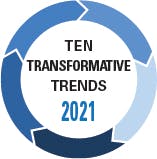Well before the COVID-19 pandemic began to upend all facets of the healthcare ecosystem, many organizations were thinking about how they could become more consumer-centric, while subsequently deploying strategies to do so. Granted, consumerism in healthcare is still very much an emerging concept, but forward-thinking hospitals and health systems have been ramping-up efforts in this area.
For a patient care organization, what does it mean to be consumer-centric? A good person to ask would be Kevan Mabbutt, who is the senior vice president and chief consumer officer at Intermountain Healthcare, a 24-hospital health system based in Salt Lake City, Utah. Mabbutt, who joined Intermountain three years ago from Disney, says the words consumer and consumerism are relatively new to healthcare, and not always well understood or accepted. “But the idea is very simple,” he asserts. “We all consume products and services in our everyday lives, and we all have needs and expectations of those products and services. Healthcare should not be any different, and yet it has been. We have the same consumers as hospitality, retail, big tech, entertainment, travel and other industries, and yet we do not provide a comparable experience.”
A major part of any consumer-driven strategy is being data-driven and digitally-focused. To that end, the pandemic simply underscored the need to digitize as much as possible, for both safety and convenience purposes. In a recent Accenture report that surveyed 4,600 U.S. consumers, “meeting people at the front door” was one primary approach researchers said organizations should deploy to improve the patient experience. The survey found that 74 percent of patients said they are now likely to use online chat or texting to provide check-in information before their appointment if such a service is available.
Indeed, with the “digital front door” serving as the first impression potential patients have of a health system, online experience has become a critical component of their overall reputation. Mabbutt says that although Intermountain could not have anticipated the pandemic, in many ways the organization was still prepared for it. For example, the health system began work on its digital front door about a year before the pandemic began, and launched its digital front door tool, called My Health+ app, in the midst of the crisis. At launch, the focus of the app was heavily on needs most relevant during COVID-19—such as symptom checking, finding appropriate care, booking appointments, and getting test results—”that could all now be met from the palm of your hand in the safety of your home,” Mabbutt notes. “Just like with telehealth, from a digital point of view, the pandemic accelerated, but did not change our strategy,” he adds.
Mabbutt believes that the ideal digital front door needs to do two core things: first, be able to anticipate and meet the needs of Intermountain’s patients, members, and caregivers, and second, do that in a way that matches the best digital experiences anywhere—not just in healthcare. He explains that the My Health+ tool accomplishes this by addressing patients’ biggest pain points, which are all about finding, managing and paying for care.
“When it comes to execution, we look at the best digital experiences outside of healthcare—for example, booking air tickets online, or simplified and transparent payment tools—to inspire how My Health+ addresses those pain points. We have built our digital front door as a platform that enables us to swap tools in and out as technology evolves—and to expand its scope to include wellness, patient education, remote monitoring, and a host of other tools in future.” So far, the results back up Intermountain’s strategy: the My Health+ app has acquired around 400,000 users since its launch last summer, Mabbutt reports. “Not only have we scaled more quickly than we anticipated, but our users are spending far longer with the app than they did on our legacy patient portal. They are using the dozens of tools integrated into My Health+ and they rate the experience three times as highly as the legacy portal in the app stores,” he adds.
At Banner Health, a mission to make patients’ lives easier
In Arizona, the 28-hospital Banner Health has been making its own inroads in digitally enhancing the patient experience. Senior leaders at the Phoenix-based health system decided a few years ago that their mission would change to “doing whatever possible to make healthcare easier, which in turn makes life easier,” says Christopher Stallings, senior director of consumer digital at Banner Health.
What does that work entail? For one, scrapping the traditional waiting room, Stallings reports. Due to COVID-19, “We have basically ditched the waiting room [from how it previously was structured] and made it so that patients can wait in their car and get texts, giving them updates on their wait time and when to come in,” he says. The idea is to avoid the busy waiting room where there could be other germs that are spreading. Although the virtual waiting room model originated at Banner pre-COVID, Stallings says that with the virus “being as dangerous as it is, this strategy was definitely accelerated by the [pandemic].” He additionally notes that there have even been discussions to use the freed-up waiting room space for clinical purposes.
Another key digital front door strategy in response to the crisis at Banner has been simplifying the online scheduling process. Months before the pandemic began, Banner begun offering online scheduling for consumers through an already existing provider match platform the health system was using from patient access solutions company Kyruus. After building a detailed directory of more than 10,000 providers in the Kyruus platform, the health system deployed the provider match tool to give consumers a more modern and efficient way to search for providers on its website. Already enabling consumers to search based on a range of key matching criteria, Banner then expanded this to include filtering based on which providers offer online booking. From there, an integration with the health system’s electronic health record (EHR) platform allows consumers to choose an appointment based on real-time availability, health system officials explain.
Then in March 2020 as the pandemic started to unfold, the organization’s clinical and digital teams recognized that they could leverage the online scheduling it was already doing to do the same thing for COVID-19 testing and flu shot appointments. “So we were actually able to use creative thinking and work together to reinvent or repurpose those existing capabilities,” says Christen Castellano, vice president of customer experience channels at Banner Health. “And that allowed us in December to [think about] how we could do this in a scalable way for vaccines. That’s really been the opportunity gained—taking your digital front door assets and thinking creatively about how we could make them portable to a new situation,” she says. And as of late January, just one month after launching the tool for vaccine scheduling, Banner had more than 110,000 vaccine appointments scheduled online, Castellano reports.
Indeed, in the era of COVID-19, the time for health systems to address patient experience is now, as it’s arguably never mattered more. There is a financial incentive to do so, too: the aforementioned Accenture research indicated that those health systems that evolve to meet new consumer experience needs can expedite financial recovery and capture patients from competitors, potentially increasing their revenues by 5 percent to 10 percent pre-COVID levels within 12 months. For a $5 billion health system, this would mean between $250 million and $500 million in additional annual revenues.
As such, moving forward, leaders at Intermountain and Banner strongly believe they need to keep innovating and adapting to meet consumers’ needs. Mabbut specifically refers to Intermountain’s My Health+ tool as “a living thing.” He says, “We cannot stand still and declare that the digital front door is ‘finished.’ It is key to how we stay relevant to consumers in an increasingly competitive and complex healthcare environment. And just like the Disney experience, we see it as an important differentiator for the organization.”


